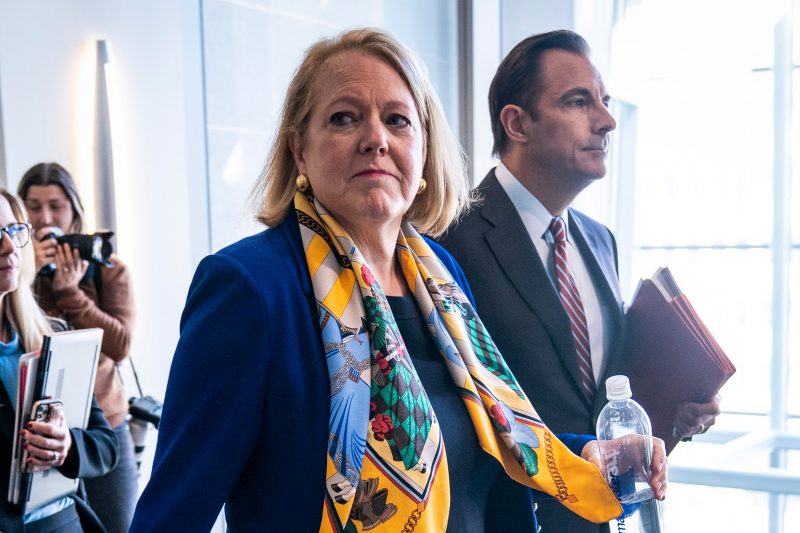Clarence Thomas’s argument for accepting billionaire GOP donor Harlan Crow’s largesse over the years and not disclosing it leans heavily on the claim that Crow didn’t have business before the court.
That defense isn’t going to cut it when it comes to the news that conservative judicial activist and Thomas family ally Leonard Leo proactively obscured a payment to Thomas’s wife, Virginia “Ginni” Thomas. So Leo has gone with a different and rather blunt explanation. Effectively it’s: Yes, I did it, because I wanted to hide it.
The Washington Post reported late Thursday that documents show Leo in 2012 instructed GOP pollster Kellyanne Conway to bill a nonprofit he advises and pay Ginni Thomas $25,000. He also told her, “No mention of Ginni, of course.”
The nonprofit, the Judicial Education Project, would go on to file multiple amicus briefs to the court in key cases. In other words, the source of the money Ginni Thomas was paid later had plenty of interest in the decisions of the court on which her husband serves.
The key questions include how much Thomas knew about his wife’s work. (The couple have long maintained that they keep Ginni Thomas’s conservative activism separate from Justice Thomas’s jurisprudence and don’t discuss each other’s work.) Beyond that, there are questions of how much money Leo might have directed to Ginni Thomas over the years and what kind of work she did for him, given that these matters could also have ties to the Supreme Court.
But also, consider Leo’s explanation.
In a statement, he said of his move to keep Ginni Thomas’s name off the paperwork: “Knowing how disrespectful, malicious and gossipy people can be, I have always tried to protect the privacy of Justice Thomas and Ginni.”
First, what else is he going to say? There was clearly an effort to shield the connection. Second, this is Leo effectively saying he was justified in obscuring that connection because it might be made to look bad. He might contend it would unfairly be made to look bad. But it’s the opposite of the concept of transparency, which holds that matters involving public officials should be there for everyone to evaluate, and that people should draw their own conclusions about potential conflicts of interest.
Thomas’s own approach to these matters, it would seem, mirrors Leo’s.
He once disclosed the luxury trips and expensive gifts he accepted from Crow. But after the Los Angeles Times in 2004 cast a spotlight on them using those disclosures, Thomas stopped disclosing them (save for one gift in 2015).
Likewise, Thomas in 2002 disclosed a $5,000 gift for the education of a grandnephew he had custody of and was raising as a son. But when Crow reportedly paid for the same grandnephew’s $6,200 monthly private boarding school tuition later that decade, Thomas did not disclose it. (We only learned about this Thursday.)
In 2011, Thomas announced he would amend 13 years’ worth of filings after it was pointed out they should have included his wife’s employers. But just three years later, in 2014, he failed to disclose a real estate sale involving Crow that ostensibly was covered by the very same disclosure laws.
An article on the Volokh Conspiracy blog on Thursday offered a plausible explanation for this. It cited Thomas’s writings in both the landmark Citizens United case and another. In them, Thomas took a dim view of the impacts of disclosure requirements. He argued that in some cases they can chill speech that is constitutionally protected.
The piece then offered this rather sympathetic summary.
“I think we can draw a general sense of how Justice Thomas approaches ethics rules: Justice Thomas discloses what he is required to disclose, but declines to disclose optional information that would allow critics to attack him, his family, and his friends,” it says. “Thomas’s apparent goal is not to shield any actual or apparent conflicts of interest. … His goal seems to be to protect his privacy from critics that have been trying to destroy him for more three decades.”
But Thomas has in fact failed to disclose all that he was required to, by his own admission. And it’s not difficult to see how this kind of sense of persecution could be used to justify plenty to yourself — and in the process create even more problems.
The timeline here is also key. That’s because Leo’s move to obscure the payment to Ginni Thomas came a little more than a year after Ginni Thomas departed her own nonprofit amid conflict-of-interest and other questions.
The group, Liberty Central, was launched with the help of a $500,000 anonymous contribution (later reported to have been from Crow). It also put out a 2010 memo with her name on it labeling then-President Barack Obama’s proposed health-care overhaul unconstitutional. The latter was a problem because it was logical to assume such questions might come before Justice Thomas’s court (which they ultimately did). So the nonprofit took her name off the memo. After these and other issues, Ginni Thomas stepped down in November 2020, with the nonprofit citing “distractions.”
Leo served on the board of Liberty Central.
The payment from the Judicial Education Project also, notably, came a year after Justice Thomas acknowledged that he had incorrectly omitted his wife’s employers from his disclosures and amended the reports.
The lesson Leo took from all of this was apparently that the best course was to obscure these matters, to avoid rekindling that debate. The problem with that approach is that when it does come out, it looks a lot like a coverup.
That’s not exactly a recipe for avoiding suspicion, whether “malicious” or otherwise. Nor is it a recipe for instilling confidence in a conservative justice whose ethics even many Republicans are now questioning.

